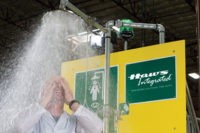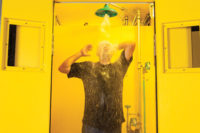Several factors go into the determination as to whether or not any given facility and/or job site requires an eyewash or shower system,” says Michael Pennington of Safety Management Group. As a consultant at a pharmaceutical research facility, Pennington is all too familiar with incidents where workers - in his case, lab personnel - come into contact with potentially toxic substances and have to use a local eyewash/shower system.
“Properly selected, located and installed systems, coupled with employee/contractor knowledge of location and the use of these systems, go a long way toward minimizing and in many cases avoiding injuries altogether,” says Pennington.
For those who are considering installing such systems, he recommends first conducting a two-tiered hazard assessment for the work area, one that takes into account both the existing hazards of the work area and those introduced by the work activity.
“The presence and handling of chemicals that contain a high or low pH is the most common indicator dictating the need of an eyewash and/or shower system to be present in the work area,” Pennington said. “An EHS professional should account for costs associated with the purchase, installation and long-term maintenance while determining what types they need.”
Additional factors:
- Are there existing structures that the stations can be mounted to?
- Are there area drains?
- Any weather extremes?
- Is the system needed for a long-term or temporary basis?
Pennington also says that a strong understanding of both OSHA regulations and ANSI specifications is necessary in order to properly develop an eyewash/shower program for a facility or worksite.
The employer's responsibilities
OSHA requires facilities for quick drenching or flushing of the eyes “where the eyes or body of any person may be exposed to injurious corrosive materials” (29 CFR 1910.151(c) and 29 CFR 1926.50(g)). As Pennington indicates, corrosive materials generally have a very low pH (acids) or a very high pH (bases). Strong bases are usually more corrosive than acids. OSHA’s Hazard Communication Standard at 29 CFR 1910.1200, Appendix A, defines a corrosive as a chemical that “causes visible destruction of, or irreversible alterations in, living tissue by chemical action at the site of contact.”
In letters of interpretation answering compliance questions, agency Enforcement Director Richard Fairfax said “Exposure” referred to a worker being subjected to a chemical in the course of employment through any route of entry, including inhalation, ingestion, skin contact or absorption.
Fairfax said that it is up to the employer to determine if employees “can or will be exposed during the course of their duties to hazardous materials in such a way that the protections of an eyewash or emergency shower would be necessary.”
The mere presence of hazardous materials at a worksite does not necessitate an eyewash or emergency shower, if there’s no possibility for exposure to occur (i.e., if the chemicals are in sealed containers that will not be opened). Fairfax gave the following example where an eyewash or emergency shower would be needed: “If the building piping containing caustic materials has, at certain locations, a spigot or tap from which the contents are to be sampled or withdrawn and employees are expected to perform such tasks.”
OSHA regulation 29 CFR 1910.151(c) does not provide specific instruction regarding the installation and operation of emergency eyewash and shower equipment. Fairfax said it is the employer’s responsibility to assess the particular conditions related to the unit, such as water temperature, to ensure that it provides suitable protection against the caustic chemicals/materials to which employees may be exposed.
What are the standards?
As for the current ANSI standard ([Z]358.1-2004), Fairfax notes that while it does not have the force of a regulation under the OSH Act, it does provide for eyewash and shower equipment “in appropriate situations when employees are exposed to hazardous materials. ANSI’s definition of ‘hazardous material’ would include caustics, as well as additional substances and compounds that have the capability of producing adverse effects on the health and safety of humans. ANSI’s standard also provides detail with respect to the location, installation, nature and maintenance of eyewash and shower equipment.”
Avoiding mistakes
Pennington said most eyewash/shower system mistakes are related to location, maintenance, signage and training of personnel.
“It is an absolute must that these systems are properly maintained, located and unobstructed within certain specification of the hazards they are intended to protect personnel against, identified by appropriate signage, and personnel trained in the use and location of these systems,” he said. “Without these common mistakes being caught by an effective management program, then your investment dissipates and the safety of your personnel becomes compromised.”





